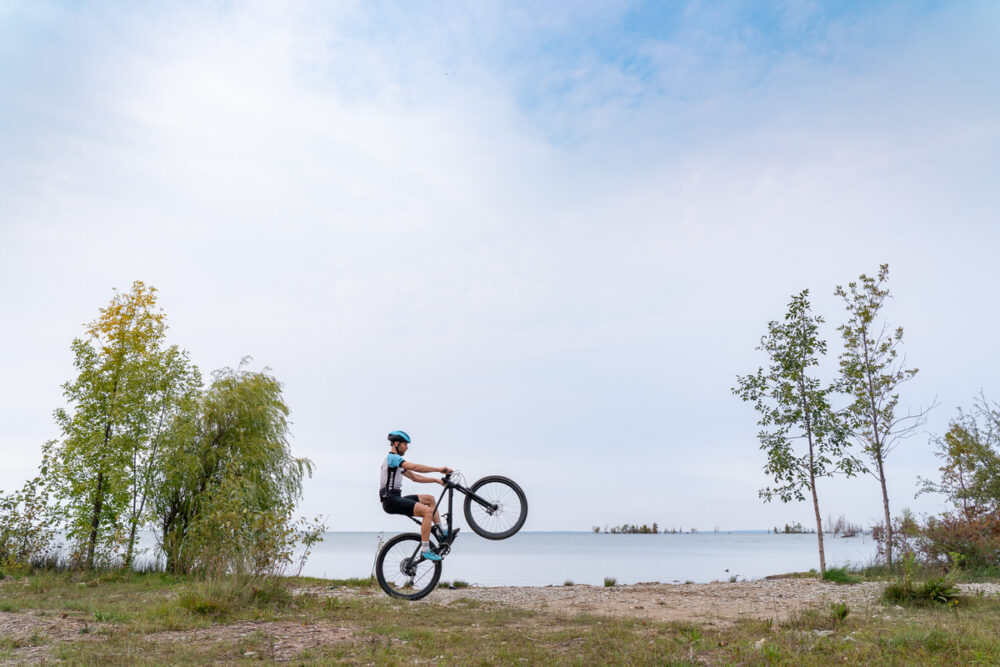Live fast or die trying?
Risk or Cost: Benefits are worth considering when you plan out your training, whether your goal is in the realm of elite/extreme, or improved fitness, or even if it is more health-oriented. There is a ‘risk’ with certain actions and in particular today I wanted to discuss, or ponder, the idea that sometimes ‘more’ is simply just more and not better. That is, applying more stimulus (e.g. intensity/volume/dieting, etc) may not cause the same benefit and indeed, will start to cause regression at some point as the risk involved increases.
Mechanical Risks
This is a simple risk to (mostly) mitigate with proper prep: Keeping bikes clean and in good working condition, doing regular maintenance… and carrying the spare tools and extras you need to handle most of the issues that might arise on a ride. (Tire plugs, extra tubes, a mini pump in addition to a CO2, a chain link, a derailleur hanger, enough water/food for an extra couple hours of riding, lights if it might get dark…)
Technical Risks: Skills Training + Practice
Physical risks in training are more obvious. We need to straddle the line between being a corny Triple-X adrenaline junkie and a nervous runner who sticks to the same 5K road out-and-back every single day. With that idea of long-term ‘goal’ in mind, it would be irrational to do a ‘stunt’ or ‘obstacle’ or ‘look at me’ in hopes that a single day or intervention will speed you to your goal but we also can’t progress by applying the same, monotonous and ‘light’ load. We need to find the right level of stress or ‘stimulus’.
In the case of technical skill training, this means repeatedly asking,”Is this a 10/10 chance of success (99.9%) or is this a gamble, a 1/10?” Many people are not sure where this ‘reasonable’ line is. Dan John has perhaps said this the best, “reasonable is repeatable”. Focus on fundamentals, skill instruction, regular practice, and minimizing the downside of our practice with pads & appropriate progression. The beginner’s mindset and, well, enjoying the cliche journey.
Physiological Risks: sometimes more is just more (not better)
Many of the athletes we coach are (friggen awesome) Endurance Athletes. Many have progressed their capacity over many years and can do ‘big’ rides regularly. I get concerned when the progression or regularity of REALLY big rides starts to increase. How many 12-hour training rides can we do? When is a training ride a ‘race’ or ‘challenge’ and how many of these hugely depleting events can we handle. Intense rides, beat-down workouts, and vomit-inducing sessions are also to be questioned. What is the risk and are they repeatable?
When thinking about these big sessions and the idea of consistency and ‘when can we train again’ can you see that there is a risk of doing too much? In a week/month/year will you be motivated and making progress? Where is the line? if a 3-hour ride is better than 90 minutes, then a 6-hour ride must be better again? How far does that logic go?
There isn’t one right answer, every athlete will have to decide on their appropriate level of risk versus potential reward for themselves. But you should start thinking about where your line is, and if it needs to shift in one direction or the other.
Consider that the ‘optimal’ will become less with a more busy life and your capacity for training stress will generally grow as life gets less hectic. In Greg Lehman terms your capacity for training load is influenced by how ‘other stuff’ is in your cup. If work/family is busy then there is less room in the cup for training stress. The question of what is going on in your life outside of training is very important and difficult but essential to long-term progression.

How much can you fit in this Snazzy Consummate Athlete Cup? What are the different things that fill your cup? (you can order these in our shop – click the image!)
As an endurance athlete, you have a choice to do strength (or not). You can ride/run/train more (or less). You can skip your weekly yoga (or prioritize it). You can take that supplement (or not). You can sleep a lot (or not much). The question is how do you deal with the risk:reward on these decisions?
Overall health
Sometimes, we neglect our overall health when we’re focused hard on a training outcome. (Read more about that here.) But we do that at our own risk. And for almost all of us, it’s simply not worth it. So even though we’re mentioning this one last, it’s the most important for your longevity in life and sport! Don’t prioritize training and racing at the cost of enough sleep, eating well, taking care of dental/PT/gynecological etc. issues. And even family and relationships can count in this category, since a big part of a healthy life is having good, solid relationships.
Stimulus and Risk (The Inverted U)
On a recent episode of the Consummate Athlete Podcast, we talked to Joe Friel about the idea of optimal training amount and risk. Joe proposed that as you train more at some point, the returns start decreasing but the risk keeps increasing. In graphical form, this might be like the below graph where the curve starts dipping down. This is all theoretical but how much do you need to reach your goals and when is more just more?

Volume
The above curve can move from side to side. If it moved to the right the optimal zone would allow for more ‘stimulus’ (bottom x-axis). Moving the curve to the right or ‘making your cup bigger’ lets you train more and likely become more fit. I have clients who retire and there is ‘less in their cup’ so they can gradually train more! Conversely, other clients are having children, dealing with health concerns, or doing amazing things at work and so we must consider that this will shift their curve to the left or leave less room in the cup.
A critical consideration when thinking about long term training is that we can increase our capacity over time but if we go from 10 km rides to 200km rides it is likely we will burn through our adaptive capacity (discussed in this episode with Dan Cleather) and not reach the same performance level, or find things like motivation, energy waning as the months and years pass by. If we start with 200km rides, all the supplements, the latest technology, and altitude camps … well I am not sure what we do in year 2 (or 10) of your training!
Consistency and Longevity
Staying in the sport, or doing your favourite sport(s) ‘forever’ is a good goal for an adult athlete and is central to our idea of ‘The Consummate Athlete’. If you are pushing the limits of your capacity then the graph (and common sense) suggests that you would be at higher risk of injury, burnout, illness. So if consistency or ‘doing fun stuff for a long time’ is the primary goal then we reflect if you are on the left side of the curve at the ‘minimum effective dose’. We want to keep some room in our cup.
Finding the minimum effective dose
The left side of the curve or the ‘less’ approach is evident when a) you are progressing b) you are enjoying the process c) you feel like you *could* do more. The last one is the key. If you feel like there is some slack in the system you have the capacity to absorb days that get harder due to training or lifestyle factors. You have room to absorb that crummy day at work or extra load that the kids put on you or that ride that goes extra long.





